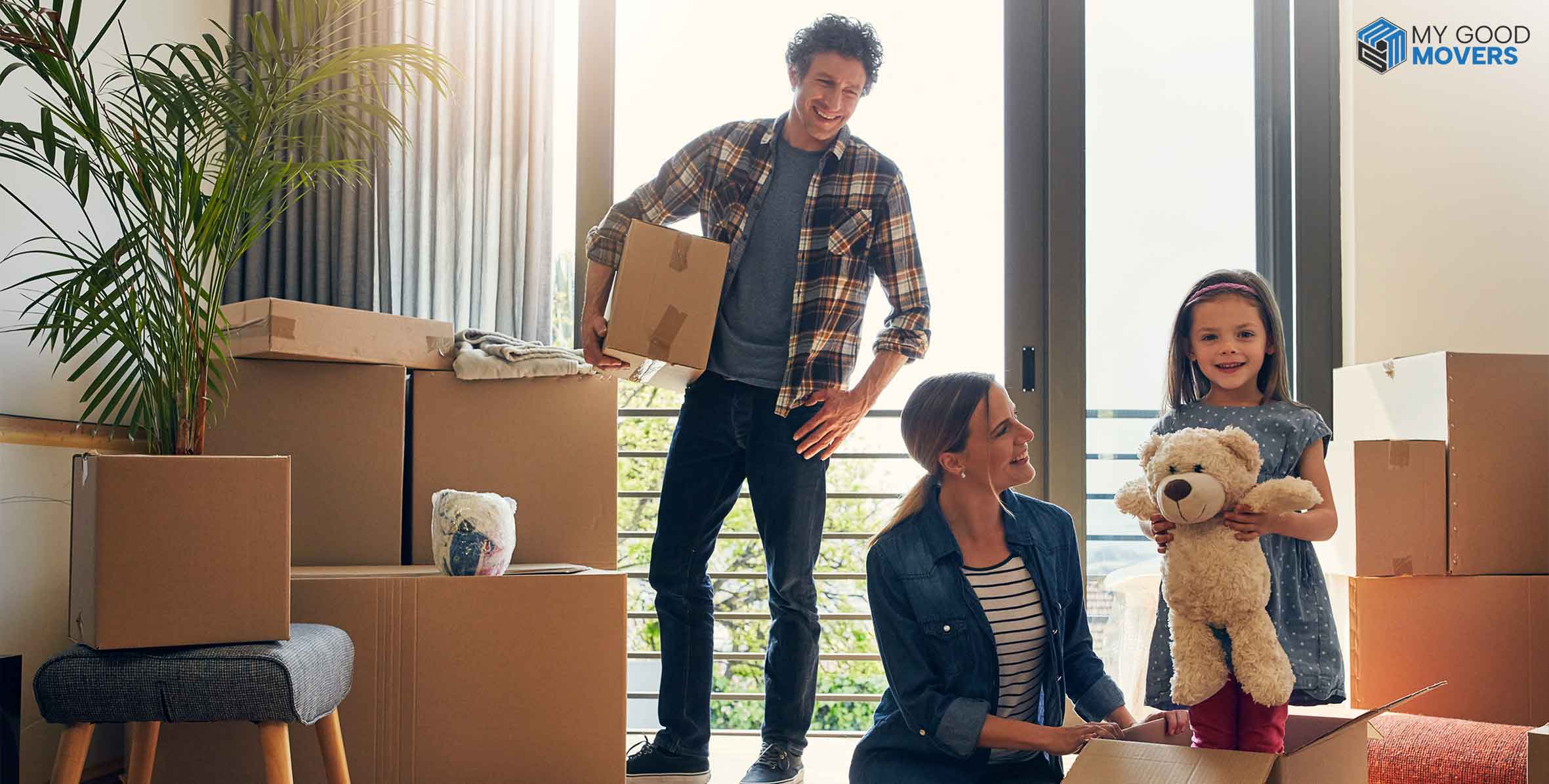"Change is the only constant in life," and it couldn't be more true when it comes to moving across the country.
Whether you are chasing a new career opportunity, seeking a better lifestyle, or simply ready for a fresh start, moving across the United States is a major move that many people undertake each year.
In fact, over 7.9 million Americans moved between states in the previous year alone.
It is a figure that has steadily increased since the rise of remote work during the pandemic.
And yet, despite the new opportunities, moving cross-country can be financially and emotionally stressful.
When you are staring at the map, plotting your route from coast to coast or across state lines, the numbers can give you a headache.
The average cost of moving long-distance ranges from $2,200 to $5,700.
But don’t worry—there are ways to manage these expenses and even save money along the way.
If you are anything like most people, the biggest concern is probably figuring out how to tackle this enormous task without breaking the bank.
But with the right plan and a little guidance, it doesn’t have to be that way.
So, let's break it down step-by-step and learn tips and tricks for moving across the country, as well as how to save money, time, and energy.
Plan Early and Budget Smart
The key to a smooth move is starting early.
The average move across the U.S. can range anywhere from $1,500 to $6,000.
However, it depends on your distance, the amount of belongings, and whether you are hiring professionals or doing it yourself.
The earlier you start planning, the more you can save money along the way.
What are the Cheapest Ways to Move Cross Country and Save Money
Budget is always the biggest concern for most movers.
But there are ways to make this less painful on your wallet.
Here are some of the cheapest ways to move cross country and save money:
Rent a moving truck
There are different companies that allow you to pack and move your belongings on your own schedule. It’s cost-effective but can be physically demanding.
Use moving containers
Some companies drop off containers at your location, which you load at your pace. They then ship the container to your new destination.
Hire a moving labor company
If you want some muscle at a reasonable cost, you can hire just the labor to load and unload your stuff without paying for the full-service moving company.
Declutter before the move
Sell or donate items you no longer need. Moving fewer things means less packing and less space needed.
How to Move Across the Country in 15 Steps
Moving across the country can seem like a monumental task, but when you break it down into steps, it becomes much more manageable.
Create a Moving Checklist
Start by outlining all the tasks you need to complete before the move.
This includes everything from finding movers to packing, transferring utilities, and notifying relevant parties.
According to a study, over 58% of people felt more in control when using a moving checklist.
Set a Budget
Moving costs can add up quickly, so it is essential to set a budget.
It includes major expenses like hiring movers, truck rentals, moving containers, and smaller costs.
The average long-distance move can range from $2,000 to $7,000.
Pick a Moving Date
Timing can significantly impact the cost of your move.
Moving during the summer or on weekends will cost you more.
If possible, choose a weekday between October and April when rates are lower.
Moving during the off-peak season can save you as much as 30%.
Research Moving Companies
Whether you are using professional movers or doing a DIY move, it’s important to research your options.
Get quotes from at least three different moving companies.
Look at reviews and check for any hidden fees or extra costs for stairs and elevators.
Moving scams affect around 13% of people, so it is critical to do proper research.
Declutter and Downsize
The more stuff you move, the more it will cost.
Take this opportunity to declutter—sell, donate, or recycle items you no longer need.
According to a survey, 37% of Americans regret not downsizing before a move, which could save you hundreds of dollars in moving expenses.
Notify Important Parties
Before you move, make sure to notify your employer, insurance companies, and any subscription services about your new address.
Don’t forget to forward your mail through the USPS.
It’s also important to update your address with the IRS, DMV, and voter registration offices.
Transfer Utilities
Schedule the disconnection of utilities at your old home and the connection of services at your new place.
This includes electricity, gas, water, internet, and cable.
It’s a good idea to arrange these a couple of weeks in advance to avoid any gaps in service.
Over 30% of movers face delays in connecting their utilities.
Get Packing Supplies
Packing materials can add up quickly if you’re not prepared.
You will need boxes, tape, bubble wrap, markers, and protective blankets.
On average, expect to spend between $100 to $300 on packing supplies.
To save money, try asking local stores for free boxes or use household items like towels to cushion fragile items.
Start Packing Early
Packing takes more time than you might think, so start early.
Start by packing non-essential items like out-of-season clothes or rarely-used kitchen essentials.
By spreading out the packing over a few weeks, you’ll reduce stress and make the process more manageable.
Label Everything
When packing, label each box with its contents and the room in which it belongs.
This will make unpacking much easier.
Color-code boxes based on rooms to help the movers place them in the right areas.
According to moving experts, properly labeling boxes can save up to 30% of your unpacking time.
Cancel or Transfer Memberships
Don’t forget to cancel or transfer any local memberships you have, like the gym, library, or community organizations.
Also, make sure to cancel any local utilities and subscriptions like newspapers or meal kits.
Take Care of Your Vehicle
If you are driving across the country, make sure your vehicle is in good shape.
Get an oil change, check tire pressure, and ensure that all fluids are topped off.
If you’re not driving, research shipping options.
Car shipping can cost anywhere from $600 to $1,200, depending on distance and the type of vehicle.
Pack an Essentials Box
When you arrive at your new home, the last thing you want to do is search through boxes for your toothbrush or bed sheets.
Pack an essentials box with items like toiletries, a few clothes, medications, important documents, and some basic kitchen items.
Do a Final Walk-Through
Before you leave your old home, do a final walk-through to make sure you didn’t forget anything.
Check all closets, cabinets, and drawers.
It’s also a good idea to take photos of the empty rooms for your records.
Unpack Essentials First
When you arrive at your new home, unpack the essentials first—like your bedroom and kitchen.
According to moving experts, unpacking the essentials within the first 48 hours can reduce post-move stress.
Tips for Moving Across the Country
Here are some tips for moving across the country to keep your stress levels down:
Stay organized: Moving across the country can be chaotic. Keep a binder or folder of all your moving-related paperwork and contacts.
Budget for hidden costs: Don’t forget costs like tipping the movers, cleaning supplies for your new home, and a night in a hotel if your move takes more than a day.
Move off-season: If you can, avoid peak moving months (June-August) for better rates.
Be flexible: Expect some things to go wrong or get delayed. Give yourself extra time for unforeseen hiccups.
Get help: Don’t be afraid to ask for help from friends or family, whether it's packing or providing meals during moving chaos.
Choose a Moving Option: DIY or Professional Movers?
This is one of the most critical decisions you'll make.
Hiring professional movers offers convenience, but it’s also more expensive.
Doing it yourself could save thousands, but it requires much more work.
Professional movers
They handle everything—packing, loading, and transporting.
This option provides peace of mind and minimizes your physical workload.
The cost typically ranges between $4,000 to $10,000, depending on your move type.
DIY move
Renting a truck and doing it yourself can cost as little as $1,500.
However, the stress of driving a large vehicle across the country and the physical effort of packing and unpacking cannot be overlooked.
How Much Does It Cost to Move Across the Country?
When you are thinking about how to move across the country, one of the first questions that comes to mind is, “How much is this going to cost me?”
Let’s be real—cross-country moves are expensive, but understanding where your money goes will help you plan better.
Hiring Professional Movers
If you’re thinking of going with professional movers, it’s important to note that they handle most of the work. But this convenience comes with a higher price.
For a long-distance move across the country, the cost can range from $4,000 to $10,000.
| Size of Home | Approximate Cost (1,000–2,500 miles) |
|---|---|
| Studio/1 Bedroom | $1,800 – $3,500 |
| 2–3 Bedrooms | $4,000 – $7,000 |
| 4+ Bedrooms | $7,000 – $10,000+ |
Additional Costs with Professional Movers
Packing Services: Most companies charge extra to pack your belongings. Expect to pay $300 to $1,500, depending on the size of your home.
Insurance: Basic coverage is included, but full-value protection costs more. For instance, full-value coverage for a $50,000 move might cost around $500 to $1,000.
Specialty Items: Moving pianos, artwork, or bulky items like hot tubs could add $200 to $1,000.
Tips: It’s customary to tip movers about $4 to $5 per hour per mover, which could add up to $100 to $300, depending on the move.
DIY Moving
If you are on a budget, DIY moves offer a great way to save money, but you’re going to do more of the heavy lifting.
Here are three common DIY options:
Truck Rental
Renting a moving truck is one of the cheapest ways to move, especially for smaller moves. However, you’ll need to consider gas, tolls, and the physical effort of driving a large truck across the country.
| Truck Size | Cost of Rental (1,000–2,500 miles) | Fuel Cost |
|---|---|---|
| 10' (Studio) | $1,200 – $1,800 | $300 – $400 |
| 16' (1–2 Bedrooms) | $1,500 – $2,500 | $400 – $600 |
| 26' (3+ Bedrooms) | $2,000 – $4,000 | $600 – $800 |
Moving Containers
Moving containers is another cost-effective choice.
They deliver a container to your home, you load it, and they transport it across the country.
It's cheaper than hiring a full-service mover but more expensive than a truck rental.
| Container Size | Cost (1,000–2,500 miles) |
|---|---|
| 8' (Small Move) | $1,500 – $2,500 |
| 16' (2–3 Bedrooms) | $2,500 – $4,500 |
Freight Trailer
Some companies offer freight trailers where you only pay for the space you use.
They are ideal for larger households, and you handle all the packing and unpacking.
| Trailer Space | Cost (1,000–2,500 miles) |
|---|---|
| 12' (2 Bedrooms) | $2,500 – $3,000 |
| 17' (3+ Bedrooms) | $3,500 – $5,000 |
Other Moving Costs
Packing Supplies: On average, expect to pay $100 to $300 for boxes, tape, bubble wrap, and other packing materials.
| Item | Cost |
|---|---|
| Moving Boxes | $1.50 – $3 per box |
| Tape | $2 – $6 per roll |
| Bubble wrap | $20 – $50 per roll |
| Mattress covers | $10 – $20 each |
Fuel & Tolls: Driving a moving truck that gets 10–12 miles per gallon will cost you $300 to $800 in gas. Additionally, toll roads can tack on another $50 to $100.
Temporary Storage: Sometimes, you must store your belongings for a few days or weeks before settling into your new place. Renting a storage unit could cost you $50 to $200 monthly.
Factors That Affect the Cost of Moving Across the Country
Distance: The farther you move, the more you’ll pay, especially with long-distance moving companies, which often charge per mile.
Amount of Belongings: More items mean a bigger truck and more time, which adds to the cost.
Moving Method: Are you hiring professional movers, renting a truck, or using a moving container? Each option comes with its own price tag.
Time of Year: Summer is peak moving season, which can increase costs by 20-30% compared to off-season months.
Additional Services: Packing, storage, and insurance all contribute to the final cost.













































































































































 (239) 799–6077
(239) 799–6077